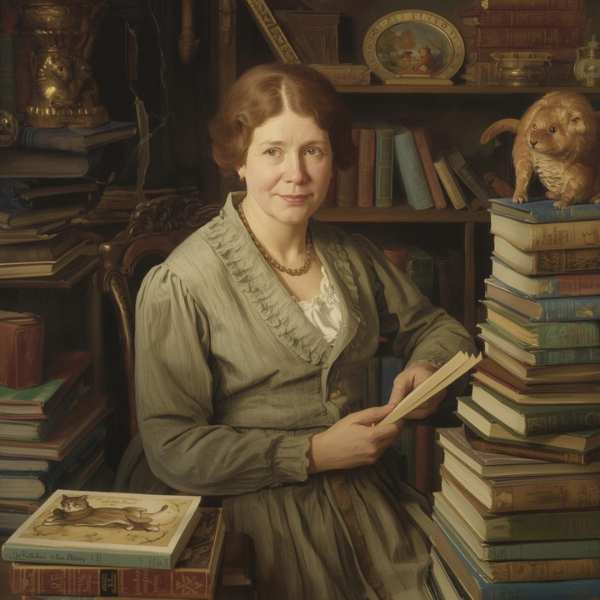
A Tale That Began in the English Countryside 🌿
When people think of the world’s most beloved children’s authors, Beatrix Potter stands as one of the brightest names. Her enchanting stories, led by the mischievous Peter Rabbit, have charmed readers for more than a century. But Potter was more than just a writer — she was also a talented illustrator, naturalist, and early conservationist, whose love for nature shaped everything she created.
Her world of talking animals, cozy English gardens, and moral lessons wrapped in charm continues to captivate readers of all ages. Yet behind her gentle watercolors and playful rabbits was a woman of strong will and vision, who defied Victorian expectations and changed the landscape of children’s literature forever.
Let’s journey through the life, art, and legacy of Beatrix Potter — a pioneer whose imagination and determination made Peter Rabbit and his friends eternal. 🐭🍄
Early Life: A Curious Mind in Victorian England 🏡
Beatrix Potter was born Helen Beatrix Potter on July 28, 1866, in London, England, into a wealthy upper-middle-class family. Her parents, Rupert and Helen Potter, were cultured but conservative — her father a barrister, and her mother an accomplished hostess in social circles.
Though Beatrix grew up surrounded by privilege, her childhood was often lonely. Like many Victorian children of her class, she was raised primarily by governesses rather than by her parents. However, solitude proved fertile ground for her imagination. She filled her days with drawing, reading, and exploring nature during family holidays in the Lake District and Scotland.
It was in these idyllic landscapes that she developed a lifelong fascination with animals, plants, and fungi — observing them with the precision of a scientist and the heart of a storyteller. 🌿🦔
A Budding Artist and Naturalist 🎨🔬
From an early age, Beatrix showed an extraordinary talent for drawing. Her sketchbooks were filled with rabbits, mice, frogs, and plants, all illustrated with remarkable detail and personality.
But her interest went beyond mere artistry. Beatrix was also deeply curious about biology and natural science. She collected mushrooms, studied their growth, and made meticulous illustrations of fungi that are still admired for their accuracy today.
In her twenties, she even pursued scientific research — developing a theory about fungal reproduction that she presented to the Linnean Society of London. However, as a woman in Victorian England, she was not allowed to present her work herself. Her findings were dismissed, but her determination to combine art and science never waned.
Beatrix Potter’s early work as a naturalist illustrator later shaped her storytelling: her animals looked and behaved like real creatures, yet they lived in a world full of human emotion and charm. 🧺🐿️
The Birth of Peter Rabbit 🐇✉️
The story that would make Beatrix Potter famous began in 1893 — not as a book, but as a letter. She wrote to the young son of her former governess, who was ill at the time, telling him “the story of four little rabbits whose names were Flopsy, Mopsy, Cottontail, and Peter.”
That simple act of kindness would change literary history. Years later, in 1901, Potter decided to self-publish The Tale of Peter Rabbit after several publishers rejected her manuscript. She printed 250 copies herself, complete with her own charming illustrations. The book was an instant success.
By 1902, Frederick Warne & Co. agreed to publish it commercially — and it became a phenomenon. Children adored the mischievous Peter, the anxious Mrs. Rabbit, and the dangerous Mr. McGregor’s garden. The book’s gentle humor, moral lesson, and vivid illustrations made it unlike anything else on the market.
The Tale of Peter Rabbit wasn’t just a book — it was the start of a literary universe. 🌷📖
A New Kind of Children’s Literature 📚
Before Beatrix Potter, most children’s stories were moralistic and heavy-handed, focusing on obedience and duty. Potter changed that.
Her stories were small in size but big in heart. She wrote with simplicity and empathy, respecting children’s intelligence and imagination. Her books didn’t preach — they invited. Each tale was a window into the secret lives of animals, filled with curiosity, humor, and just enough danger to feel thrilling.
Her writing style combined:
- Realism, drawn from her observation of nature
- Fantasy, in giving animals human traits and adventures
- Morality, shown through gentle lessons about behavior and consequences
This balance created a formula that defined modern children’s literature — one that authors like A.A. Milne (Winnie-the-Pooh) and later J.K. Rowling would follow in their own ways.
A Universe of Animals and Adventures 🦊🦆🐭
After the success of Peter Rabbit, Beatrix Potter created a series of equally delightful stories, each featuring a different animal protagonist. Between 1902 and 1930, she wrote and illustrated over 20 tales, many of which remain classics.
Here are some of her most beloved works:
1. The Tale of Squirrel Nutkin (1903) 🐿️
A mischievous red squirrel annoys the owl Old Brown with riddles — a perfect mix of wit and suspense.
2. The Tailor of Gloucester (1903) ✂️
Inspired by a true story, this book tells of a poor tailor helped by grateful mice to finish a waistcoat for the mayor — one of her most heartwarming tales.
3. The Tale of Benjamin Bunny (1904) 🥕
A sequel to Peter Rabbit, this story continues the adventures of Peter and his cousin Benjamin, full of humor and mischief.
4. The Tale of Jemima Puddle-Duck (1908) 🦆
A naive duck attempts to hatch her eggs, only to fall into the clutches of a cunning fox — a charming story with a hint of danger.
5. The Tale of Tom Kitten (1907) 🐱
Playful kittens get into trouble, capturing the innocence and energy of childhood perfectly.
Each book was not just a story — it was a miniature world, illustrated with exquisite detail and told in Potter’s gentle, musical prose.
A Pioneer in Merchandising and Copyright 💼
Beatrix Potter wasn’t just a creative genius — she was also a savvy businesswoman ahead of her time.
In 1903, she designed and patented a Peter Rabbit doll, making Peter the first fictional character to be officially merchandised. She later expanded her creations to toys, games, tea sets, and wallpapers, building one of the earliest children’s literary brands.
This innovative spirit not only increased her income but also gave her control over her own work — something rare for women authors of her era. Beatrix Potter’s careful management of her intellectual property ensured that her stories remained both financially successful and artistically protected. 💰🎨
Love, Independence, and Life in the Lake District 🌄
In 1905, tragedy and transformation struck simultaneously. Norman Warne, her editor and fiancé, died suddenly of leukemia, leaving her heartbroken. In his memory, she purchased Hill Top Farm in Near Sawrey, a small village in the Lake District.
There, she found peace, independence, and endless inspiration. The Lake District’s rolling hills, quaint cottages, and abundant wildlife became the settings for many of her later tales.
Over time, Potter became deeply involved in land conservation and farming, raising Herdwick sheep and preserving traditional rural life. She married William Heelis, a local solicitor, in 1913, and together they managed several farms.
Her devotion to nature extended far beyond her books — she eventually became a key supporter of the National Trust, donating large portions of her land to protect the countryside she loved. 🌼🐑
Art and Science United: Potter’s Legacy as a Naturalist 🌺🔍
Even as she became one of the world’s most famous storytellers, Beatrix Potter never stopped being a scientist at heart. Her art always reflected a respect for the natural world.
She observed how animals moved, how plants grew, how light touched fur and feather — and her illustrations brought these details to life. Her scientific precision, combined with her emotional sensitivity, gave her art a timeless quality.
Today, her botanical drawings and mushroom studies are preserved in museums and continue to inspire both artists and biologists alike.
A Lasting Impact: The Enduring Magic of Beatrix Potter ✨
Beatrix Potter passed away on December 22, 1943, at the age of 77, leaving behind an extraordinary legacy. She was not only a literary pioneer but also an environmentalist, feminist figure, and cultural icon.
Her stories have been translated into more than 45 languages and have sold over 250 million copies worldwide. Adaptations in film, television, and animation — including The World of Peter Rabbit and Friends and the Peter Rabbit movies — continue to introduce her characters to new generations.
What makes her stories timeless? It’s the combination of:
- Simplicity – clear storytelling and beautiful language
- Empathy – treating animals and children with understanding
- Imagination grounded in nature – where wonder meets reality
Her tales remind readers that nature, kindness, and curiosity are treasures to protect and celebrate. 🌸
Conclusion: The Quiet Brilliance of Beatrix Potter 🌿✨
Beatrix Potter lived in a world that often tried to limit women’s roles, yet she carved her own path with courage and creativity. Her blend of art, science, and storytelling not only shaped children’s literature but also helped preserve the English countryside she loved.
Through Peter Rabbit, Jemima Puddle-Duck, and countless others, she gave life to a vision of nature that was both whimsical and wise — a world where even the smallest creature mattered.
More than a century later, her stories still remind us to find joy in the simple things: a walk in the garden, a curious animal, or a gentle tale before bed. 🌼🐇
Sources :
- The Beatrix Potter Society – Official Archives
- National Trust (UK) – Beatrix Potter and Hill Top Farm
- BBC Culture – “Beatrix Potter: The Woman Who Changed Children’s Literature”
- British Library – Beatrix Potter Manuscripts Collection
- Penguin Books – “The Tale of Beatrix Potter”
- Biography.com – “Beatrix Potter Biography”
- The Guardian – “How Beatrix Potter Shaped Modern Storytelling”

